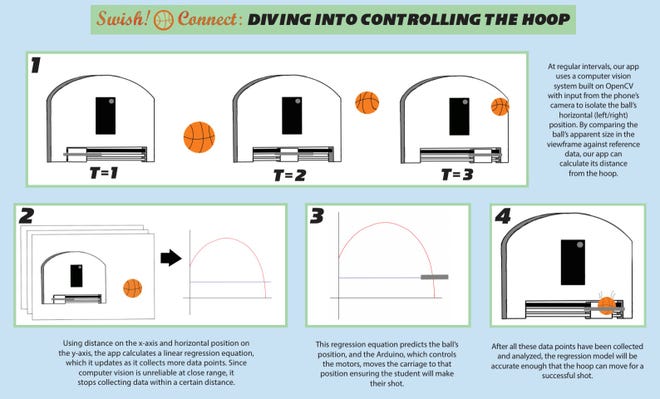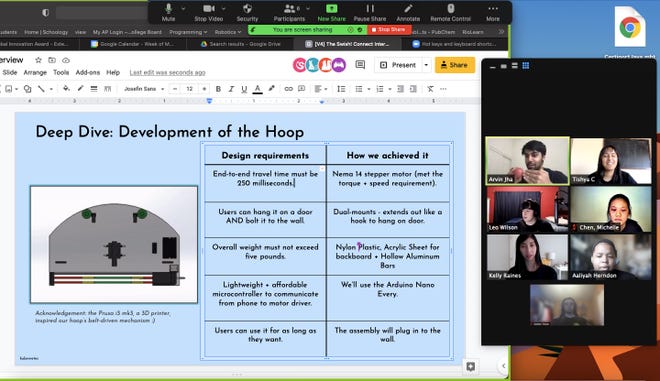This article was published on azcentral by Amaris Encinas on July 5, 2021.
When a group of high school students from Tempe was tasked to innovate in a way that could help a community achieve optimum physical and mental health, their thoughts went to people living with disabilities.
In particular, to special education students at their school, Corona del Sol High School, who struggled with motor skill development.
This is how Robotics AZTECH Team 6479 came up with Swish! Connect, a robotic, adjustable basketball hoop that helps build motor skills for the FIRST Robotics Competition, organized by FIRST, a non-profit dedicated to promoting STEM education.
The Tempe team represented the state of Arizona as one of the Top 20 finalists in the 2021 FIRST Global Innovation Awards on June 30 — out of 850 applicants worldwide. And while the team didn’t place for an award, their idea is one already in the works, being developed by a professors at ASU and in the planning stages for testing within the Tempe Union High School District.
How Swish! was born
The challenge required teams to identify a problem or opportunity to help a community regain or achieve optimum physical and mental health through movement.
The prompt was distributed in January and the seven team members had two months to create a solution. The teams were tasked with preparing a presentation, a business pitch and an explanation of the technologies needed to make the Swish! Connect to come to life, said Tishya Chhabra, president and innovation challenge lead.
When ideating on what kind of product to create, Chhabra and her teammates looked to people like Calvin, a special education student in their district who struggled to get a basketball into the hoop on his own.
They found that special education students had a more difficult time with motor skill development. The Individuals with Disabilities Education Act services approximately 7.3 million students, which makes up for 14% of all public school students, according to team member Kelly Raines.
Tackling this problem could be a way to assist physical therapists in their efforts to bring a student’s motor skill levels up, which is of particular importance when physical therapists in school districts are spread thin. Particularly, in the Tempe Union High School District, where there is one physical therapist for seven schools, Chhabra said.
“Those are 7.3 million kids we could potentially help,” Chhabra said.
According to information collected by the team, a study conducted in 2018 and 2019 found that special education students only reach up to 55% motor skill mastery by age 20, Chhabra said.
A hoop, a website and an app

The three components to Swish! are the hoop, the website and the app.
The hoop’s main functionality is its left and right movement. The hoop moves based on the accuracy of the shot. The closer the hoop moves to the center, the better your progress, according to team member Arvin Jha.
The hoop is attached to an extendable mount, one that can be hung on a wall or against a door, allowing for more versatility for the hoop placement, according to former team member Corbin Tinnin.
The adjustment of the hoop, or the slide, was created by two colored aluminum rods with linear bearings to help the slide move smoothly from left to right, Tinnin said.
The app will actively monitor adjustment levels as a student throws the ball in real-time. Eventually, the hoop will remain stationary because the student will be able to shoot more accurately, Chhabra said.
“We want to push the user to improve their motor skill. When we limit how much the hoop moves left to right, we will push the user to try to be more accurate with their shots. The goal is to have students make at least 70% of their shots,” Chhabra said.
The phone or tablet is connected to the backboard and its camera feeds the data from the ball’s trajectory into the app and website to chart progress over time. The data can be used by both the physical therapist and the student to adjust therapy techniques based on their progress, Jha said.
The app is designed to cater to the student, one where applause invokes motivation, as well as allowing the student to make their own adjustments instead of adhering to predetermined adjustments, Jha said.
On the website, there are activities recommended for users to practice motor skills through other activities, like tying their shoes based on data collected by the hoop.
“All three aspects work together to gather knowledge and boost confidence,” Jha said.
A virtual competition season

The 2021 competition season was unlike any other, it was completely virtual.
All teams had the opportunity to participate in a few different challenges: Innovation Design Challenge, Game Design Challenge and the At Home Challenge, according to lead mentor Stephen Heiser.
Instead of the jam-packed event spaces the team was used to, virtual challenges were introduced into the mix, Chhabra said.
The students could create their own FIRST Robotics Competition game, compete in driving challenges or code autonomously, Heiser said.
What made the countless hours on Zoom worth it to prepare for the Innovation Challenge was how the team eventually bonded despite the struggle to work entirely online and the fact that they did not all know each other at first.
For team member Aaliyah Herndon, robotics has become a place of comfort, “What is so nice about robotics is that once you are a part of it, you never really stop being a part of robotics. We are a very tight-knit community, being a part of this team is enough to make us a family.”
A prototype to come
No robot can be complete without a working prototype, so Team 6479 will be working with assistant professor Hani Ben Amor at Arizona State University, director of the ASU Interactive Robotics Laboratory, to help with the programming side of things, Chhabra said.
Specifically, working on controlling and detecting the ball in the air as it moves into the hoop, Chhabra said.
Eventually, the prototype will be tested in the Tempe Union High School District.
Though Team 6479 did not place on June 30, they did win the “Who wants to be an innovator” game show at the FIRST Global Innovation Awards, according to a tweet by Team 6479.
Though Team 6479 chose to make Swish! Connect to help special education students, Swish! as a concept is “solid enough” that it could be used as a training tool for basketball players or as a foundation for other games like ring toss or darts farther down the line, Chhabra said.
“The possibilities are limitless,” she said.
Reach breaking news reporter Amaris Encinas at amaris.encinas@arizonarepublic.com or on Twitter @amarisencinas.